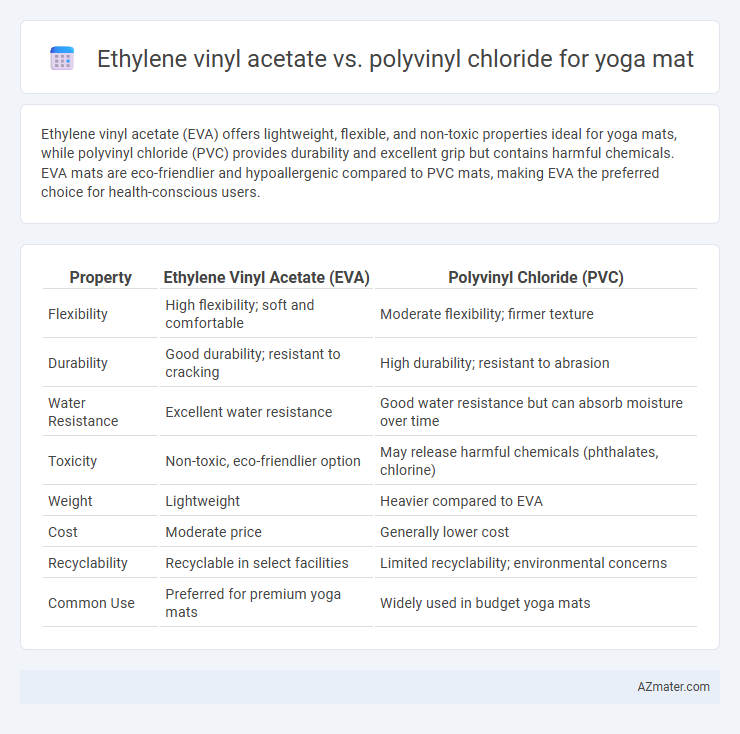Ethylene vinyl acetate (EVA) offers lightweight, flexible, and non-toxic properties ideal for yoga mats, while polyvinyl chloride (PVC) provides durability and excellent grip but contains harmful chemicals. EVA mats are eco-friendlier and hypoallergenic compared to PVC mats, making EVA the preferred choice for health-conscious users.
Table of Comparison
| Property | Ethylene Vinyl Acetate (EVA) | Polyvinyl Chloride (PVC) |
|---|---|---|
| Flexibility | High flexibility; soft and comfortable | Moderate flexibility; firmer texture |
| Durability | Good durability; resistant to cracking | High durability; resistant to abrasion |
| Water Resistance | Excellent water resistance | Good water resistance but can absorb moisture over time |
| Toxicity | Non-toxic, eco-friendlier option | May release harmful chemicals (phthalates, chlorine) |
| Weight | Lightweight | Heavier compared to EVA |
| Cost | Moderate price | Generally lower cost |
| Recyclability | Recyclable in select facilities | Limited recyclability; environmental concerns |
| Common Use | Preferred for premium yoga mats | Widely used in budget yoga mats |
Introduction to Yoga Mat Materials
Ethylene vinyl acetate (EVA) and polyvinyl chloride (PVC) are two popular materials commonly used in yoga mats, each offering distinct properties for practitioners. EVA is lightweight, flexible, and eco-friendly, providing excellent cushioning and durability, which enhances comfort during yoga sessions. PVC, known for its high density and non-slip texture, offers superior grip and longevity but may contain chemicals less favorable for those seeking non-toxic or environmentally sustainable options.
Overview of Ethylene Vinyl Acetate (EVA)
Ethylene Vinyl Acetate (EVA) is a lightweight, flexible, and durable material commonly used in yoga mats for its excellent cushioning and shock absorption properties. It offers superior resilience and moisture resistance compared to Polyvinyl Chloride (PVC), enhancing comfort and hygiene during practice. EVA mats are also eco-friendlier, being free of harmful phthalates and halogens found in some PVC formulations.
Overview of Polyvinyl Chloride (PVC)
Polyvinyl Chloride (PVC) is a widely used synthetic plastic polymer known for its durability, flexibility, and water resistance, making it a common material for yoga mats. PVC yoga mats provide excellent cushioning and support but often contain harmful phthalates and additives that pose environmental and health concerns. Compared to Ethylene Vinyl Acetate (EVA), PVC mats tend to be heavier and less eco-friendly, though they offer superior grip and longevity for intense practice sessions.
Comfort and Cushioning Comparison
Ethylene vinyl acetate (EVA) offers superior cushioning and softness for yoga mats compared to polyvinyl chloride (PVC), providing enhanced shock absorption and joint protection during practice. EVA's lightweight and flexible composition contributes to greater comfort, reducing strain during extended yoga sessions. PVC mats tend to be firmer and denser, offering durability but often sacrificing the plush cushioning essential for sensitive pressure points.
Durability and Longevity Analysis
Ethylene vinyl acetate (EVA) offers superior flexibility and shock absorption, enhancing the durability of yoga mats by resisting cracking and deformation under repeated use. Polyvinyl chloride (PVC), while less flexible, provides robust resistance to wear and chemical exposure but tends to degrade faster with prolonged exposure to sunlight and sweat. EVA mats generally exhibit longer longevity due to their ability to maintain structural integrity and cushioning properties over time, making them a preferred choice for extended use.
Grip, Texture, and Slip Resistance
Ethylene vinyl acetate (EVA) yoga mats provide superior grip and slip resistance due to their closed-cell foam structure, which enhances cushioning and prevents water absorption, maintaining consistent traction during intense workouts. Polyvinyl chloride (PVC) mats feature a smoother, more durable surface but can become slippery when wet, reducing grip and posing a risk during high-sweat sessions. EVA's softer texture offers better comfort and control for balance poses, while PVC's dense composition delivers longevity at the expense of natural slip resistance.
Environmental Impact and Sustainability
Ethylene vinyl acetate (EVA) yoga mats offer better environmental sustainability due to their non-toxic, recyclable nature, and lower carbon footprint compared to polyvinyl chloride (PVC) mats. PVC production involves the use of harmful chlorine-based chemicals and releases toxic dioxins, contributing significantly to environmental pollution and health hazards. EVA mats are biodegradable under proper conditions and free from phthalates, making them a safer choice for eco-conscious consumers and reducing long-term ecological impact.
Health and Safety Considerations
Ethylene vinyl acetate (EVA) is a non-toxic, phthalate-free material commonly used in yoga mats, offering excellent cushioning and hypoallergenic properties that reduce the risk of skin irritation. Polyvinyl chloride (PVC) often contains harmful plasticizers like phthalates, which can off-gas toxic fumes and pose health risks with prolonged exposure, especially in poorly ventilated spaces. Choosing EVA mats enhances safety by minimizing chemical exposure while maintaining durability and comfort during yoga practice.
Price and Value Assessment
Ethylene vinyl acetate (EVA) yoga mats generally offer better price-to-value ratios compared to polyvinyl chloride (PVC) mats due to EVA's lightweight, non-toxic, and eco-friendly properties. PVC mats, though typically cheaper upfront, may pose environmental and health concerns because of chlorine content and potential release of harmful chemicals. Consumers prioritize EVA for durable, cushioned, and hypoallergenic features, making it a cost-effective and sustainable choice for long-term use.
Which Material is Best for Your Yoga Practice?
Ethylene vinyl acetate (EVA) offers superior cushioning, flexibility, and non-toxic properties, making it ideal for sensitive skin and joint protection during yoga sessions. Polyvinyl chloride (PVC) mats provide excellent durability and grip but may release harmful chemicals and lack eco-friendliness, raising concerns for health-conscious practitioners. Choosing EVA is best for those prioritizing comfort and environmental safety, while PVC suits users seeking long-lasting, firm mat surfaces.

Infographic: Ethylene vinyl acetate vs Polyvinyl chloride for Yoga mat
 azmater.com
azmater.com